Growing Roses in Containers:
Introduction to Growing Roses In Containers:
Rose is a medium-sized flowering plant, comes in hundreds of species and thousands of cultivars. The rose plants can be erect shrubs or climbers with sharp prickles on the branches. Rose flowers vary in size and shape and are from button size to large and showy in a wide range of colors ranging from white, red, yellow, etc. Most species of roses are native to Asia, and some are native to Europe, North America, and northwestern Africa. Roses are grown for their beauty and fragrance, they are the best ornamental plants. Rose plants are hybridized easily, to produce different varieties of roses. The leaves are borne alternately on the stem of the plant. The flowers of most species have five petals, some species have only four petals. All most all species of roses are grown in containers.
If you are planning to grow roses in your garden, but running out of place, growing in a container is the best option. They have amazing accents that brighten up our landscape and fill sweet fragrances in the air.
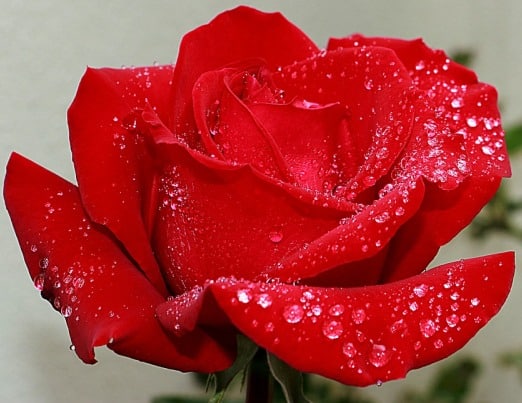
- Scientific Name for Roses: Rosa.
- Family: Roses belong to the family of Rosaceae.
- Common Names: Rosa, Rose, and Gulab, etc.
Select the Best Variety for Growing Roses in Containers:
There are many species of roses available in the market. Buy not all roses will grow well in containers. For example, some rose species are climbers, and they cannot grow well unless you put you provide some trellis or otherwise provide support, so the vined variety roses would be a bad choice for a container, as it will sprawl on the ground.
Grandifloras are the best as their name and qualities tend to be on the taller side along with large blooms. Shrub roses, species roses, and older cultivars of roses grow in bigger dimensions and make them difficult to grow in a compact area. Even the many hybrid varieties of roses grow well in the ground than in containers. Let us get into complete details of growing roses in containers.
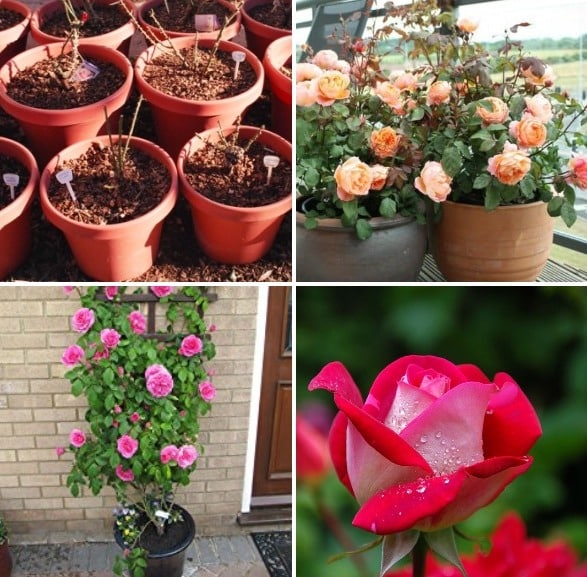
Most popular varieties suitable for Growing Roses in Containers:
- Groundcover: Have a compact size and look lovely spilling over the edges of your container. Select the variety of Grand cover roses, depending on the size of the container
- Miniature: these are well suited for the container, and these roses are cultivated to stay on the small side.
- Patio: Patio variety roses the most popular variety of roses and the size of the roses is smaller than standard roses. They are the type called floribunda, on a smaller scale.
- Polyantha: these roses are small roses grown on a small and compact plant.
- New Year Rose: Best container variety rose, grows well in partial to full shade. Flower in fall or early winter. Flower bio-colored.
- Showbiz Rose: Best container rose, grows well in shade. Flowers in late spring and early summer and blooms repeatedly.
- Cathedral Rose: Best container variety rose, grow well in full sun. Flowers from July to September.
- Electron Rose: this variety suits in containers, spring is the best planting time. Requires full sun, flower color is pink.
- Angel Face Rose: these are medium-sized flowers in Lavender color. These rose plants grow well in containers.
- Europeana Rose: these are medium-sized flowers in velvet dark red. Flowers form in large clusters and grows well in containers.
- Garden Party Rose: these are medium-sized flowers, in burgundy, pink and white colors. Blooms in mid-spring to mid-fall and grows in full sun.
- Ivory Fashion Rose: these are medium-sized flowers, in white colors. Blooms in late spring and early summer. Suits for growing in containers.
The best time or season for Growing Roses in Containers:
- Spring to early summer is the best time to plant roses in containers.
- Rose plants should be transplanted as soon as possible to the new and large container, as they as sold in very small nursery containers.
- In USDA zones 9-11 and in subtropical and tropical regions, the rose plants can be planted anytime between fall to winter.
- If planting a bare root rose plant, first keep their roots submerged in water for at least 1 to 2 hours, this makes roots accumulate easily in a new environment.
Suitable container size for Growing Roses in Containers:
- Roses need a spacious container to
- Miniature roses need containers of size 6-18 inches in height and 6-8 inch width.
- Large specimen roses need containers of size 18 inches or 46 cm.
- Box planters, wooden barrels, and washtubs are the best choices for growing large roses.
- If planning to move containers around in your garden, use lightweight containers. Use containers made from materials like plastic, fiberglass, and recycled composites.
- Grow bags are also the best choice that is easy to pick and move around.
- If using containers made of terracotta, ceramic, and concrete using a plastic line, as these materials heat up quickly and potting soil dries out quickly. A plastic liner can help to retain the moisture in the soil.
- The Container should have a good draining capability; the container should have one or two drain holes at the bottom.
- Watering logging can damage the growth of the plant.
- Add a 1-inch thin layer of gravel at the bottom of the container. Use small stones or pea-sized gravel. These help to promote proper draining and prevents dripping of the soil.
Planting Methods for Growing Roses in Containers:
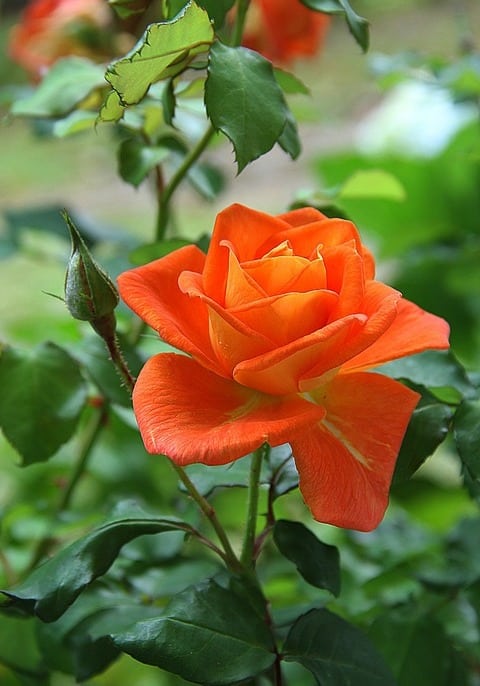
- Using good quality potting soil is recommended over using ordinary gardening soils.
- A standard commercial potting mix rich in nitrogen and phosphorous is the best choice of roses in containers.
- Enrich the potting soil with a handful of garden compost, animal manure, or peat, these will add additional nutrients into your potting soil.
- Fill up to 2/3rd of the container with the potting mix. Filling till the top of the containers will give roots of the plants suffocated.
- Homemade potting soil: Equal parts of gardening soil + organic compost + Cow manure. These are the best compositions of rose plants.
- Use bone meal or humus to enrich the potting mix before plantings. Or can mix slow-release granular organic fertilizer to the potting mix before planting.
- Buy selected rose plants from a nearby reputed nursery.
- Dig a hole at the center of the container. Some plant needs 6 inches deep holes and some need 18 inches deep depending on the size and root ball of the plant.
- Remove the rose plant carefully from the nursery pot and replant it in the desired container.
- Pack the soil firmly, make sure that there should be a 1-inch gap between the surface of the soil and the rim of the container.
- Water the plant thoroughly and place it a place where it receives 5 to 6 hours of sunlight.
Staking for Growing Roses in Containers:
- If growing full-sized varieties, insert a garden stake at the center of the containers. And tie it to the plant’s lower canes using a looped rubber band or piece of twine.
- Insert stakes as deep as possible, the stake should reach the bottom of the container.
- If using large containers, insert multiple stakes. Or can use garden cages to give support the rose plants.
Sunlight for Growing Roses in Containers:
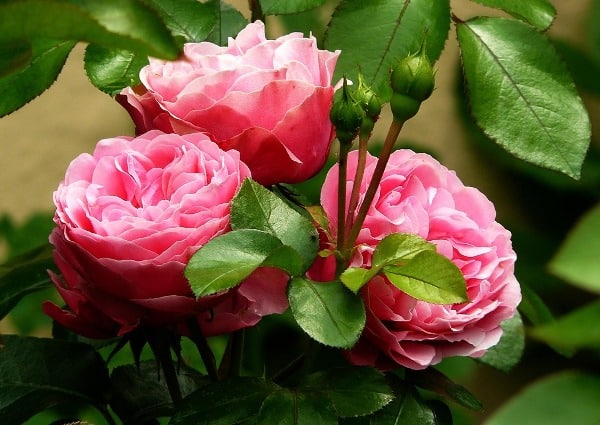
- Place containers in a location where it gets 6 to 7 hours of sunlight per day.
- The Rose plant thrives in warm and bright light locations. Rose container should be placed south facing.
- If growing indoors, place the container in a near window facing west or south facing. Where it gets a minimum of 6 to 7 hours of sunlight.
- Place the container in the outdoors on a sun-drenched balcony, patio, terrace gardens during warm weather.
Water for Growing Roses in Containers:
- Roses in containers should be planted very carefully. Roses need well-drained soil, as it prevents root rot, but the growing medium should be capable of holding some water.
- Water the plants when the top layers of the soil look dry. Should keep the potting soil moist constantly. The soil should have good moisture as rung out sponge.
- Water the rose plants before 10 AM and after 6 PM daily. Avoid wetting the foliage, as this leads to fungus diseases.
- Drip irrigation is the best method for rose gardening in containers. In drip irrigation, the systems are designed to supply water directly to the roots of the plants.
Re-potting for Growing Roses in Containers:
- Repot or change the soil every 3 to 4 years.
- The plant should be re-potted before root-bound.
- For healthy growth of the plant. Potting soil should be changed every two years. The plant depletes the nutrient levels in the soil and makes it compacted, a fresh potting soil can keep the constant supply of nutrients to the plant.
- And fertilizers used can build up the salts, which can damage the rose, so the changing of potting is highly recommended every two years.
Pruning for Growing Roses in Containers:
- The rose plants should be pruned in the spring season before the plant starts blooming.
- Pruning also maintains the shape of the plant and keeps it in a compact size.
- Dead and fading blooms should be inspected regularly and should be pruned immediately.
- Pruning the dead blooms will encourage the formation of new flowers in their place.
Winter Care for Growing Roses in Containers:
Read about Growing Money Plant in Pots.
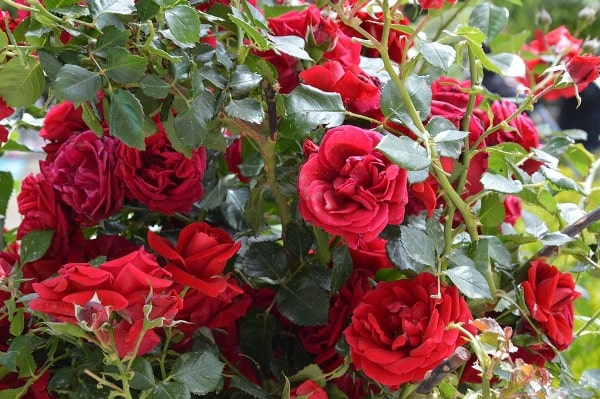
- Rose plants should need proper care during freezing winter temperatures.
- Container plants get much colder than the plants grown in the ground.
- In tropical regions where the winter temperature is very mild, and rose plants are not much affected.
- In the case of temperature below 10°C, proper care should be taken:
- Mulching: During cold winter temperatures, add to the plants and mound it around the pot to add insulation. Mulch should not get contacted with stem, which can cause fungal or bacterial diseases.
- Cover the plants with garden cloches or plastic covers.
- Or move the containers to indoor, garage, or greenhouses.
Fertilizers for Growing Roses in Containers:
- Roses are good feeders, and a plant grown in containers should be fertilized regularly.
- Rose plants should be fertilized every week for the healthy growth of the plant with good blooms.
- Use balanced organic liquid fertilizers or granular slow-release fertilizer in a ration of 10:10:10 or 5:5:5.
- Don’t over-fertilize the plant, it may show the worse effect on the plant.
- Water the plants immediately after fertilizing.
- Apply fertilizer only at the bottom of the plant, avoid contact with leaves. Leaves may burn if it gets contacted with fertilizer.
- Use eggshells, onion peels, or compost tea every week, which are natural feeds that enrich the soil with nutrients.
Pests or Diseases in Growing Roses in Containers:
- The most common pests that affect the rose plants are aphids.
- Aphids congregate on the buds and leaves of the plants. Aphids suck the juices and make the buds or leaves wither.
- Aphids can be controlled by, using a hose to spray, spray the mild soapy or salted water in the morning hours.
- Aphids can be cleaned with hands.
Tips for Growing Roses in Containers:
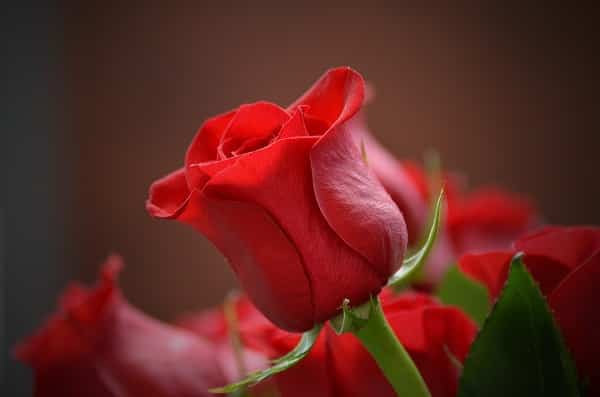
- Select the rose plant that suits for container and your Consider the temperature, light, humidity, water before selecting a variety of rose plants.
- During the blooming periods, increase the frequency of fertilization.
- Over-fertilization in rose plants can cause root burn.
- Rose plants grown outdoors need more fertilizers than rose places grown indoors.
- The rose plant should have proper air circulation to the base of the plant. Roots take some good nutrients from the surrounding air.
- Rose plants are easily affected by fungal and bacterial diseases from other plants.
- Damp the root of the rose plant before it is planted in a new container, and it should be planted in a deep as it used to grow in the previous container.
- The freshly planted rose plant should be watered through till the water drips out from the draining holes and place in shady areas where it can receive 3 to 4 hours of sunlight for a few days. Later move them to the brighter areas where they can receive 6 to 7 hours of sunlight. This makes the rose plant more adaptable to the climate.
- the Rose plant should be fertilized after 2 to 3 weeks of planting, feeding the planting with special rose mix fertilizer is highly recommended. Rose mix fertilizer is available in all garden stores, nurseries, and even online stores.
- All-purpose fertilizer can also be used for the plant instead of a rose mix, rose plants should be given manure and compost every couple of weeks.
- Except for the North facing balconies, roses can be grown in every type of balconies.
- In the case of South-faced balconies, roses should be protected from the hard sun in mid-afternoon during the summer seasons.
- The potting mix should be changed every year during the spring or the beginning of growing seasons or the top layer of the soil should be replaced with compost or manure.
- Rose plants prefer slightly acidic and rich fertile soil as a growing medium. Soil that highly acidic or alkaline can trouble the plant in taking nutrition from the soil.
- Rose plants should be watered deeply, two to three times a week during the summer seasons. And should be watered deeply once a week during the other seasons.
- 2 to 3-inch layers of mulch around the rose plant can limit the evaporation of water. Organic mulch can nourish the soil with rich nutrients and keeps roots insulated from cold winters and harsh summers. Mulching can control weeds.
- Giving the Epsom salt to the plant during the beginning of growing seasons can strengthen the growth of the rose plant. Mix 1 tablespoon of Epsom salt in one gallon of water.
You may check this: Okra Growing Tips, Ideas, Secretes, and Techniques.
- How to Make Houseplants Bushy: Effective Tips and Ideas
- Innovative Strategies for Boosting Coconut Pollination and Yield
- Pollination Strategies for Maximum Pumpkin Yield
- The Complete Guide to Chicken Fattening: Strategies for Maximum Growth
- Natural Solutions for Tulip Problems: 100% Effective Remedies for Leaf and Bulb-Related Issues
- Revolutionizing Citrus Preservation: Towards a Healthier, Greener Future
- Natural Solutions for Peony Leaf and Flower Problems: 100% Effective Remedies
- Maximizing Profits with Avocado Contract Farming in India: A Comprehensive Guide
- Natural Solutions for Hydrangea Problems: 100% Effective Remedies for Leaf and Flowers
- The Ultimate Guide to Choosing the Perfect Foliage Friend: Bringing Life Indoors
- From Sunlight to Sustainability: 15 Ways to Use Solar Technology in Agriculture
- The Ultimate Guide to Dong Tao Chicken: Exploring from History to Raising
- The Eco-Friendly Makeover: How to Convert Your Unused Swimming Pool into a Fish Pond
- Mastering the Art of Delaware Chicken Farming: Essentials for Healthy Backyard Flocks
- 20 Best Homemade Fertilizers for Money Plant: DIY Recipes and Application Methods
- How to Craft a Comprehensive Free-Range Chicken Farming Business Plan
- Brighten Your Flock: Raising Easter Egger Chickens for Beauty and Bounty
- How to Optimize Your Poultry Egg Farm Business Plan with These Strategies
- Subsidy for Spirulina Cultivation: How Indian Government Schemes Encouraging Spirulina Farmers
- Ultimate Guide to Raising Dominique Chickens: Breeding, Feeding, Egg-Production, and Care
- Mastering the Art of Raising Jersey Giant Chickens: Care, Feeding, and More
- Ultimate Guide to Raising Legbar Chickens: Breeding, Farming Practices, Diet, Egg-Production
- How to Raise Welsummer Chickens: A Comprehensive Guide for Beginners
- How to Protect Indoor Plants in Winter: A Comprehensive Guide
- Ultimate Guide to Grow Bag Gardening: Tips, Tricks, and Planting Ideas for Urban Gardeners
- Guide to Lotus Cultivation: How to Propagate, Plant, Grow, Care, Cost, and Profit
- Agriculture Drone Subsidy Scheme: Government Kisan Subsidy, License, and How to Apply Online